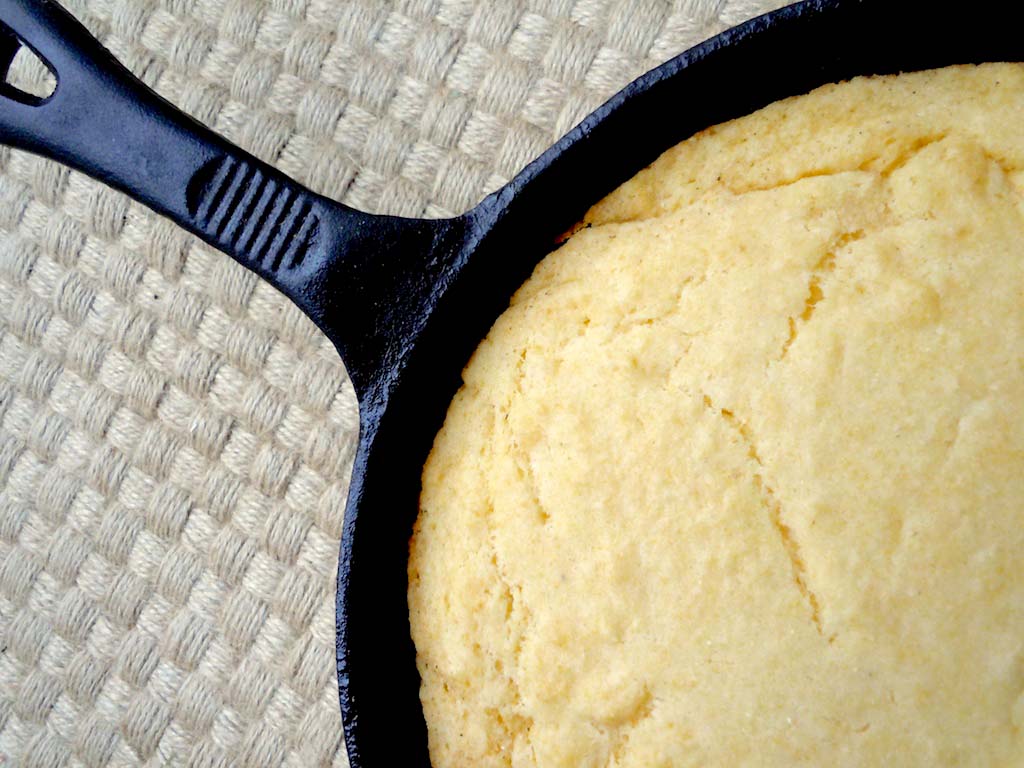 [T]raditions. More and more — in terms of cooking and beyond –it seems the option one grew up with, be it a recipe, cooking method, practice, is the correct and only one.
[T]raditions. More and more — in terms of cooking and beyond –it seems the option one grew up with, be it a recipe, cooking method, practice, is the correct and only one.
Take cornbread, for example. I do like a sweet cornbread, but because of my family’s declaration that a true cornbread should NOT be sweet (for that, there is cake), and should have at least a 50/50 ratio of cornmeal to flour (for corny crunch), I cannot eat a sweet, delicate-textured version without feeling I have committed some sort of affront to my family crest and the bowl of chili accompanying the bread.
And stuffing? In our house it was never stuffed — it was served outside the bird in a 13- by 9-inch pan with its less dramatic and somewhat unfitting name of “dressing.” This was not really due to health considerations (as has been encouraged for some time now), but more out of respect for the dressing and the bird. We’ve done enough to these birds just to get them to our kitchens. I declare nothing is more an assault to animal-kind than the turducken, where one critter is slammed inside another for the express purpose of satisfying our culture’s already over-gluttonous and hedonistic practices. A criminal act. Have we not been cruel enough? It’s like the seven deadly sins have landed on one plate.
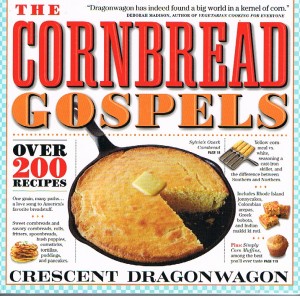 Enough with the preaching and on to the gospels. “The Cornbread Gospels
Enough with the preaching and on to the gospels. “The Cornbread Gospels
” is a delightful cookbook about a favorite family bread. Why shouldn’t cornbread be celebrated like a religion — it is homey, unfussy, completely down-to-earth…simple, hearty and delicious. I could spend a year making all the breads in this book — yes, there are that many variations on breads concocted from cornmeal. The book is filled with all manner of cornbreads: savory to sweet, muffins to johnnycake, tortillas to spoon bread, yellow cornmeal to blue. In the book, you’ll find Southern cornbreads, such as “Truman Capote’s Family’s Cornbread”; Northern cornbreads, like “Vermont Maple-Sweetened Cornbread”; southwestern cornbreads spiked with chile peppers, global cornbreads, such as “Broa,” a Portuguese cornbread made with yeast, and such earthly American fried renditions as corn fritters and hush puppies.
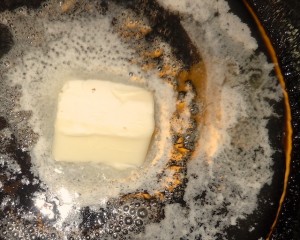 “The Cornbread Gospels
“The Cornbread Gospels
,” written by a woman with the most curious name of Crescent Dragonwagon (this is her actual name, and to find out more of the history of it, go to www.crescentdragonwagon.typepad.com/). is not only a great source of recipes (more than 200), but a highly entertaining read. Dragonwagon, who ran Dairy Hollow House, an inn in Eureka Springs, Ark., is well-practiced in baking cornbreads. Her “Skillet-Sizzled Cornbread” was served to Bill Clinton and it is one of the bread recipes from her book I felt compelled to try, drawn to it for its 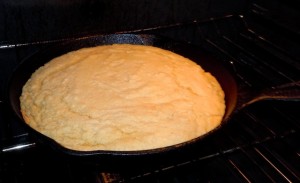 simplicity and traditional style. A 50/50 ratio of cornbread to flour! Limited amount of sugar! Made in a cast iron skillet first heated to impart that “sizzle” to the batter as it is poured in.
simplicity and traditional style. A 50/50 ratio of cornbread to flour! Limited amount of sugar! Made in a cast iron skillet first heated to impart that “sizzle” to the batter as it is poured in.
I made that recipe a few times. It comes together so quickly, it’s as easy as any packaged mix. It has a somewhat fine and tender texture, but is sturdy enough to be sliced to eat or cubed for cornbread dressing (recipe below). Tangy with buttermilk, it is also full-flavored given that high ratio of cornmeal.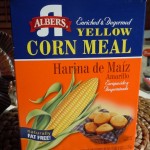
Dairy Hollow House Skillet-Sizzled Cornbread
From “The Cornbread Gospels” (2007)
Makes 8 wedges
Vegetable oil cooking spray
1 cup unbleached white flour
1 cup stone ground yellow cornmeal
1 tablespoon baking powder
1/4 teaspoon salt
1/4 teaspoon baking soda
1 1/4 cup buttermilk
2 tablespoons sugar
1 egg
1/4 cup mild vegetable oil
Pam
2 to 4 tablespoons butter
Directions:
Preheat oven to 375. Spray a 10-inch cast iron skillet with cooking spray and set aside.
Sift together the flour, cornmeal, baking powder and salt in a medium bowl.
In a smaller bowl, stir the baking soda into the buttermilk. Whisk in the sugar, egg, and oil.
Put the prepared skillet on over medium heat, add the butter, and heat until the butter melts and is just starting to sizzle. Tilt the pan to coat the sides and bottom.
Pour the wet ingredients into the dry and combine them quickly, using as few strokes as possible. Scrape the batter into the prepared pan and bake the cornbread until it is golden brown, about 20 minutes. Let cool for a few moments, and slice into wedges.
As I mentioned, I could spend 2013 just doing “cornbread of the month” from Dragonwagon’s book…not a bad idea. Certainly, I am tempted by nearly every page, every recipe, but one in particular brought me to a screeching halt and set my salivary glands in motion.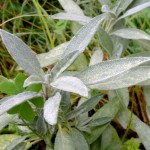
“High Desert Blue Corn Muffins with Sage and Toasted Pine Nuts”…I could only think “yowsa”! Must try and soon. Since these fell in the sweeter bread category, I chose to make them one Sunday morning for breakfast, after a rain, and went out and picked fresh sage leaves from my yard.
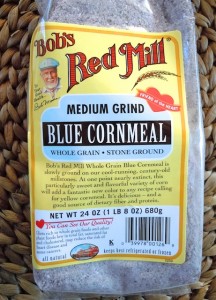 Blue cornmeal is a little harder to find…I ordered mine from a great resource for grains and flours, Bob’s Red Mill (www.bobsredmill.com). As a nutrition note, blue cornmeal, it would seem, contains more protein and more fiber than yellow cornmeal and has a deeper, grainer flavor.
Blue cornmeal is a little harder to find…I ordered mine from a great resource for grains and flours, Bob’s Red Mill (www.bobsredmill.com). As a nutrition note, blue cornmeal, it would seem, contains more protein and more fiber than yellow cornmeal and has a deeper, grainer flavor.
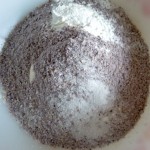 Again, another easy recipe to put together, also incorporating buttermilk (both these cornbread recipes use the method of dissolving and activating the baking soda in the buttermilk before mixing with the rest of the ingredients). Also, both recipes follow the rule most quick or batter breads insist upon almost nearly universally — do not overmix — blend the ingredients just until they come together.
Again, another easy recipe to put together, also incorporating buttermilk (both these cornbread recipes use the method of dissolving and activating the baking soda in the buttermilk before mixing with the rest of the ingredients). Also, both recipes follow the rule most quick or batter breads insist upon almost nearly universally — do not overmix — blend the ingredients just until they come together.
This muffin recipe is a keeper…all the flavors of one of my favorite places — New Mexico — in one baked good. Served hot with a little butter, the muffins are crunchy with the blue cornmeal, mildly sweet with rich brown sugar, and the chopped sage leaves fill the mouth and nasal passages with an aromatherapeutic experience rare in any breakfast bread. Delicious! My longtime friend and collaborator suggested adding blueberries next time…blue on blue might be a must-do.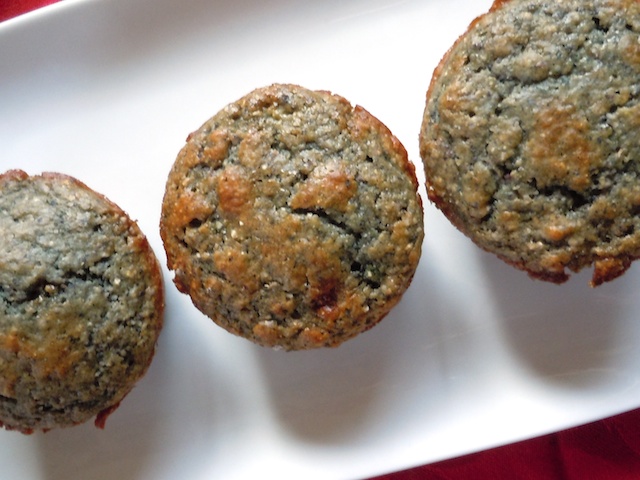
High Desert Blue Corn Muffins with Sage and Toasted Pine Nuts
From “The Cornbread Gospels” (2007)
Makes 12 muffins
Vegetable oil cooking spray
1 cup unbleached white flour
1 cup stone-ground blue cornmeal
1/2 teaspoon salt
1 tablespoon baking powder
1 1/4 cups buttermilk
1/2 teaspoon baking soda
2 eggs
1/2 cup unrefined sugar or brown sugar
1/3 cup melted butter, cooled slightly, or mild vegetable oil
1 tablespoon finely scissored fresh sage, 7 to 9 medium leaves
1/2 cup pine nuts, lightly toasted
Preheat the oven to 400 degrees. Spray a 12-cup muffin tin with oil.
Combine the flour, cornmeal, salt and baking powder in a large bowl, stirring well. Set aside.
In a medium bowl, whisk together the buttermilk and baking soda, dissolving the baking soda and and admiring the slightly dramatic foaming. Now whisk in the the eggs, sugar, melted butter or oil and sage.
Stir the combined wet ingredients into the dry mixture, until just barely blended. Then add the pine nuts with just a couple of strokes. Spoon into the prepared muffin tin.
Bake until the edges are golden brown and the tops are high and rounded, 15 to 20 minutes. Serve hot.
Blogger’s Note: I left the pine nuts out of this recipe, as one of the people I made them for does not like them.
With beloved Thanksgiving approaching, I felt I must spend some time here focused on “dressing” (hell, stuffed or not, I still call it stuffing). Next to cranberry sauce, dressing/stuffing is my favorite, truly representative of the holiday.
I had made extra pans of “Dairy Hollow House SkilletSizzled Cornbread” so that I could try the “Cornbread, Sausage and Pecan Dressing” recipe from the current issue of Bon Appetit magazine.
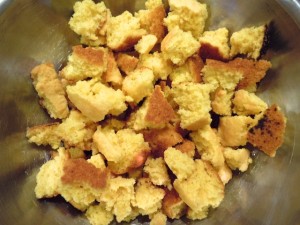 Typically, I make an Italian-themed stuffing of sourdough bread, Italian sausage and fennel bulb, but I’ve always had an affection for the cornbread version. And in this recipe, simple and delicately flavored, it had all the best aspects of this side dish that make it a favorite.
Typically, I make an Italian-themed stuffing of sourdough bread, Italian sausage and fennel bulb, but I’ve always had an affection for the cornbread version. And in this recipe, simple and delicately flavored, it had all the best aspects of this side dish that make it a favorite.
One tip I’d like to suggest to you folks out there is this: do read a recipe through thoroughly a good while before getting started. I’ve made the mistake of not doing this, making assumptions about how long it will take to make, then hit with a surprise of some extra time required for preparation. As I began the cornbread dressing recipe, I discovered — which didn’t cause too big a snafu since this was a tryout and not a holiday meal deadline — that I needed to dry my cornbread cubes in the oven…for an hour. Allow me one moment to whine here — drying cornbread in the oven is about as exciting as watching grass grow. But the end result — crunchy, firm cubes — is well worth it.
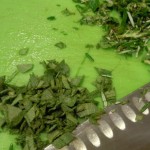 Sage and other herbs enter the picture again here, and I’m delighted to say that I could go pick parsley, sage, rosemary and thyme from my yard just outside the kitchen (one of the beautiful things about California is that you can have these herbs all year).
Sage and other herbs enter the picture again here, and I’m delighted to say that I could go pick parsley, sage, rosemary and thyme from my yard just outside the kitchen (one of the beautiful things about California is that you can have these herbs all year).
A sage-based breakfast sausage adds more flavor depth, as does a little apple cider vinegar. Onions and celery, cooked down in a heavy dose of butter, provide the traditional base flavors. Chicken broth and eggs moisten and bind. Heavenly!
This dressing will definitely have a place on my table…the celebrated cornbread remained firm and not disseminated, but the dish was moist, with a nice sweet crunch from toasted pecans, a great touch — very Southern. Just enough seasoning, and the dish holds up well as a leftover (very important).
I saw recently a book had been written imparting rules for a perfect Thanksgiving. I say the perfect Thanksgiving is this — make your own rules. Serve what you want, be it buttered toast and popcorn. Stuff your bird if that is your tradition (brrrrr) or serve your stuffing as a dressing in a lovely dish. Make it your own. And be thankful, even when your stovetop looks like an island of shipwrecked pots and pans. Be grateful…all year long.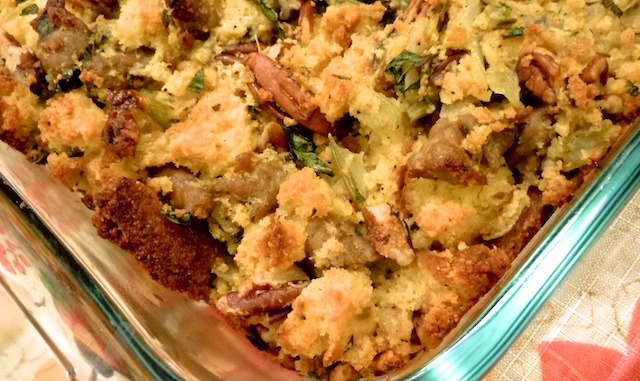
Cornbread, Sausage, and Pecan Dressing
From Bon Appetit magazine
Makes 8-10 Servings
3/4 cup (1 1/2 sticks) unsalted butter plus more for baking dish
1 pound day-old cornbread, broken into 1 1/2-inch–2-inch pieces (9 cups)
1 pound breakfast sausage links, casings removed
2 1/2 cups chopped yellow onions
1 1/2 cups 1/4-inch slices celery
1/4 cup apple cider vinegar
3 cups low-sodium chicken broth, divided
1 1/4 cups chopped toasted pecans (optional)
1/2 cup chopped flat-leaf parsley
2 tablespoons chopped fresh sage
1 tablespoon chopped fresh rosemary
1 tablespoon chopped fresh thyme
2 teaspoons kosher salt
1 teaspoon freshly ground black pepper
2 large eggs
• Arrange racks in upper and lower thirds of oven; preheat to 250°. Butter a 13x9x2-inch baking dish; set aside. Scatter cornbread in a single layer on 2 rimmed baking sheets. Bake, stirring often and rotating sheets halfway through, until dried out, about 1 hour. Let cool. Transfer to a very large mixing bowl.
• Meanwhile, cook sausage in a large skillet over medium-high heat, breaking up into 1/2-inch–1-inch pieces with a wooden spoon, until browned, 8-10 minutes. Transfer to bowl with cornbread but do not stir.
• Heat 3/4 cup butter in same skillet; add onions and celery and cook, stirring often, until softened and just beginning to brown, about 10 minutes. Add to cornbread in bowl.
• Return skillet to heat. Add vinegar; cook, scraping up browned bits from bottom of pan, for 1 minute. Pour into bowl with cornbread. Gently fold in 1 1/2 cups broth, pecans, if using, parsley, sage, rosemary, and thyme. Add salt and pepper. Let cool.
• Preheat oven to 350°. Whisk 1 1/2 cups broth and eggs in a small bowl. Fold gently into cornbread until thoroughly combined, taking care not to mash cornbread (mixture will look wet). Transfer to prepared dish, cover with foil, and bake until an instant-read thermometer inserted into the center of dressing registers 160°, about 40 minutes. DO AHEAD Dressing can be made 1 day ahead. Uncover; let cool. Cover and chill.
• Bake dressing, uncovered, until set and top is browned and crisp, 40-45 minutes longer (if chilled, add 10-15 minutes).